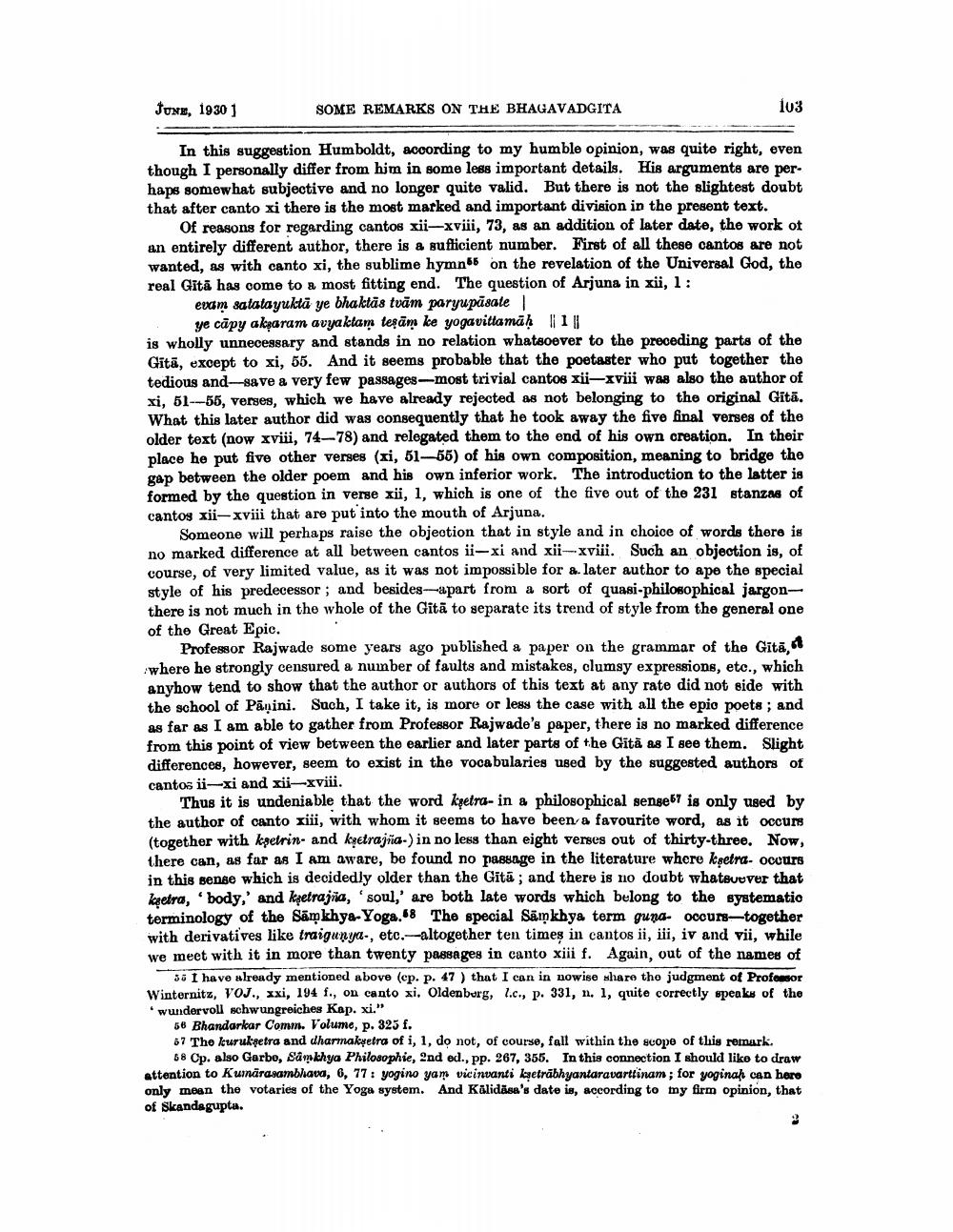________________
JUNE, 1930 1
SOME REMARKS ON THE BHAGAVADGITA
103
In this suggestion Humboldt, according to my humble opinion, was quite right, even though I personally differ from him in some less important details. His arguments are perhaps somewhat subjective and no longer quite valid. But there is not the slightest doubt that after canto xi there is the most marked and important division in the present text.
Of reasons for regarding cantos xii-xviii, 73, as an addition of later date, the work of an entirely different author, there is a sufficient number. First of all these cantos are not wanted, as with canto xi, the sublime hymn on the revelation of the Universal God, the real Gita has come to a most fitting end. The question of Arjuna in xii, 1:
evam satatayuktā ye bhaktās tvām paryupăsate
ye căpy akparam avyaktam teşām ke yogavittamāh ||1|| is wholly unnecessary and stands in no relation whatsoever to the preceding parts of the Gitā, except to xi, 55. And it seems probable that the poetaster who put together the tedious and save a very few passages-most trivial cantos xii-xviii was also the author of xi, 51---56, verses, which we have already rejected as not belonging to the original Gitā. What this later author did was consequently that he took away the five final verses of the older text (now xviii, 74-78) and relegated them to the end of his own creation. In their place he put five other verses (xi, 51–55) of his own composition, meaning to bridge the gap between the older poem and his own inferior work. The introduction to the latter is formed by the question in verse xii, 1, which is one of the five out of the 231 stanzas of cantos xii-xviii that are put into the mouth of Arjuna.
Someone will perhaps raise the objection that in style and in choice of words there is no marked difference at all between cantos ii-xi and xii-xviii. Such an objection is, of course, of very limited value, as it was not impossible for a later author to ape the special style of his predecessor; and besides-apart from a sort of quasi-philosophical jargon there is not much in the whole of the Gitā to separate its trend of style from the general one of the Great Epic.
Professor Rajwade some years ago published a paper on the grammar of the Gita, where he strongly censured a number of faults and mistakes, clumsy expressions, etc., which anyhow tend to show that the author or authors of this text at any rate did not side with the school of Pāṇini. Such, I take it, is more or less the case with all the epic poets; and as far as I am able to gather from Professor Rajwade's paper, there is no marked difference from this point of view between the earlier and later parts of the Gitā as I see them. Slight differences, however, seem to exist in the vocabularies used by the suggested authors of cantos i-xi and xii-xviii.
Thus it is undeniable that the word kşeira- in a philosophical sense67 is only used by the author of canto xiii, with whom it seems to have been a favourite word, as it occurs (together with kpetrin- and kretrajiia.) in no less than eight verses out of thirty-three. Now, there can, as far as I am aware, be found no passage in the literature where knetra- occurs in this sense which is decidedly older than the Gitá; and there is no doubt whatevever that kgetra, body,' and ketrajia, soul,' are both late words which belong to the systematio terminology of the Samkhya-Yoga.68 The special Samkhya term gund- OCCU18-together with derivatives like traigunya-, etc.--altogether ten times in cantos ii, iii, iv and vii, while we meet with it in more than twenty passages in canto xiii f. Again, out of the names of
35 I have already mentioned above (cp. p. 47 ) that I can in nowise whare tho judgment of Professor Winternitz, VOJ., xxi, 194 f., on canto xi, Oldenburg, 1.c., p. 331, n. 1, quite correctly speaks of the *wundervoll schwungreiches Kap. xi."
56 Bhandarkar Comm. Volume, p. 323 f. 67 The kurukpetra and dharmakpetra of i, 1, do not, of course, fall within the scope of this remark.
58 Cp. also Garbo, Samkhya Philosophie, 2nd ed., pp. 267, 355. In this connection I should like to draw attention to Kunarasamblava, 6, 77: yogino yam vicinvanti keträbhyantaravartfinam; for yoginak can here only mean the votaries of the Yoga system. And Kalidasa's date is, according to my firm opinion, that of Skandegupta.




